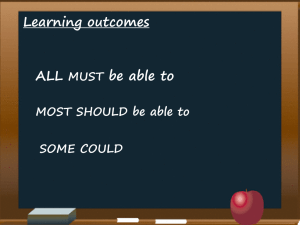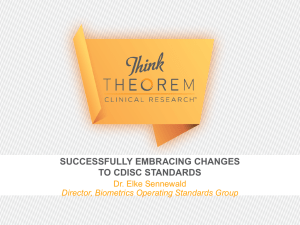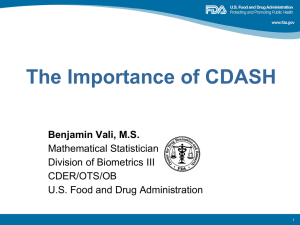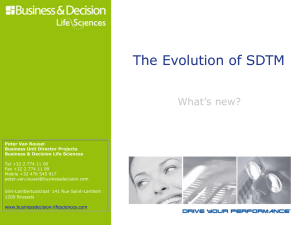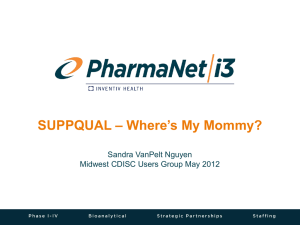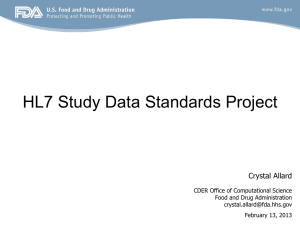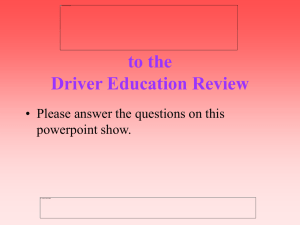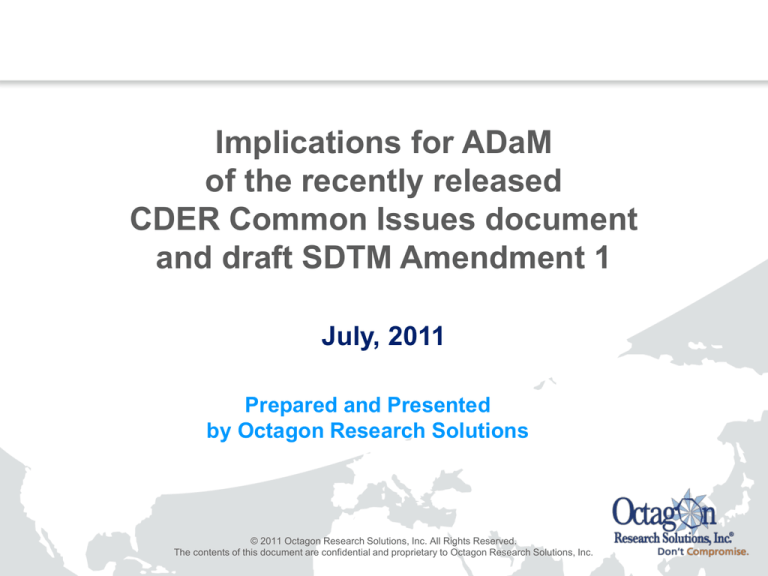
Implications for ADaM
of the recently released
CDER Common Issues document
and draft SDTM Amendment 1
July, 2011
Prepared and Presented
by Octagon Research Solutions
© 2011 Octagon Research Solutions, Inc. All Rights Reserved.
The contents of this document are confidential and proprietary to Octagon Research Solutions, Inc.
Content with ADaM Implications
•
General
– Reference documents
– Splitting large datasets
•
ADaM Content
– Coded and imputed data
– Expected analysis datasets
– Baseline variables needed in ADSL
•
Traceability
–
–
–
–
–
–
•
Tracing ADaM back to SDTM
Consistency across all datasets, including between SDTM and ADaM
Permissible variables expected in SDTM
New required and expected SDTM variables
Derivation of --STDY in SDTM
SDTM SUPPQUAL variables that support key analyses
Integration
– Common dictionaries across a submission
– Multiple records per subject in ADSL
2
© 2011 Octagon Research Solutions, Inc. All Rights Reserved.
The contents of this document are confidential and proprietary to Octagon Research Solutions, Inc.
General:
Reference Documents
• Documents to use when creating standard
analysis data
– Analysis Data Model and the ADaM
Implementation Guide (www.CDISC.org)
– FDA Study Data Specifications Document
(http://www.fda.gov/downloads/ForIndustry
/DataStandards/StudyDataStandards/UCM1
99599.pdf)
• Implications
3
© 2011 Octagon Research Solutions, Inc. All Rights Reserved.
The contents of this document are confidential and proprietary to Octagon Research Solutions, Inc.
General:
Splitting Large datasets
• Quotes from CDER document
– “The size of the LB domain is often quite large and can
exceed the reviewers’ ability to open the file using standardissue computers. This size issue can be addressed by
splitting the large LB dataset into smaller data sets according
to LBCAT and LBSCAT, using LBCAT for initial splitting.”
– “Sponsors should submit these smaller files in addition to
the larger non-split standard LB domain file. Individual file
size up to 400 megabytes is usually fine; however, it is
recommended to confirm this with the review division.”
• Implications
– This is described specifically for SDTM LB
– Applicable to other datasets, even ADaM
4
© 2011 Octagon Research Solutions, Inc. All Rights Reserved.
The contents of this document are confidential and proprietary to Octagon Research Solutions, Inc.
ADaM Content:
Coded and Imputed Data
• Quotes from the CDER document
– “Generally, no numerically coded variables should be
submitted as part of the SDTM datasets.”
– “SDTM should not include any imputed data. If there is a
need for data imputations, this should occur in an analysis
dataset, and the relevant supporting documentation to
explain the imputation methods must be provided.”
• Implications
– This work should be done in ADaM
– Be sure to include documentation
5
© 2011 Octagon Research Solutions, Inc. All Rights Reserved.
The contents of this document are confidential and proprietary to Octagon Research Solutions, Inc.
ADaM Content:
Expected Analysis Datasets
• Quotes from the CDER document
– “All submissions containing standard data are expected to
contain an ADSL file for each study.”
– “Sponsors must submit analysis datasets with their
application to support key efficacy and safety analyses.
Additionally, it is important to remember that SDTM datasets
do not have core variables (such as demographic and
population variables) repeated across the different domains.
The need for such duplication of core variables across
domains can be fulfilled through their inclusion in the
corresponding analysis datasets.”
• Implications
– Plan to always create ADSL + datasets for key analyses
– Other analysis datasets are optional
6
© 2011 Octagon Research Solutions, Inc. All Rights Reserved.
The contents of this document are confidential and proprietary to Octagon Research Solutions, Inc.
ADaM Content:
Baseline Variables needed in ADSL
• Quotes from the CDER document
– “In addition to the variables specified for ADSL in the ADaM
Implementation Guide, it is expected that the sponsor will
include multiple additional variables representing various
important baseline patient characteristics.”
• Implications
– Which baseline characteristics are important is studyspecific
– ADSL dataset specs will differ by study
– We can use study documentation and sponsor input to
determine which additional variables to include
7
© 2011 Octagon Research Solutions, Inc. All Rights Reserved.
The contents of this document are confidential and proprietary to Octagon Research Solutions, Inc.
Traceability:
Tracing ADaM back to SDTM
• Quotes from the CDER document
– “Analysis datasets should be derivable from the SDTM
datasets”
• Implications
– All our ADaM variable specs should point back to SDTM
• Possibly via other ADaM variables
– No non-SDTM source variable should be used
– Ensure USUBJID is consistent across the study
• Inconsistency was noted as a common error
– Copy SDTM variables for traceability as needed
• --SEQ, VISIT, *DTC, etc.
8
© 2011 Octagon Research Solutions, Inc. All Rights Reserved.
The contents of this document are confidential and proprietary to Octagon Research Solutions, Inc.
Traceability:
Consistency across all Datasets
• Quotes from the CDER document
– “An individual subject should have the exact same unique
identifier across all datasets, including SDTM and ADaM.”
– “Improper implementation of the USUBJID variable is a
common error that is seen with many applications, and often
requires sponsors to re-submit their data.”
• Implications
– Watch for leading or trailing spaces, zeros, etc.
– ADaM Compliance Check #53 will catch this
9
© 2011 Octagon Research Solutions, Inc. All Rights Reserved.
The contents of this document are confidential and proprietary to Octagon Research Solutions, Inc.
Traceability:
Permissible Variables Expected in SDTM
• Quotes from the CDER document
– “Examples of some of the Permissible variables in SDTM
that CDER expects to see include:”
• Baseline flags
• EPOCH designators
• --DY and STDY variables
• Implications
– If we don’t see these variables in our SDTM data, we
should suggest they be added
– Copy the baseline flag from SDTM instead of deriving
• Exception: when a different/more complicated derivation
is needed than was done in SDTM
10
© 2011 Octagon Research Solutions, Inc. All Rights Reserved.
The contents of this document are confidential and proprietary to Octagon Research Solutions, Inc.
Traceability:
New Required & Expected SDTM Variables
• Quotes from the CDER document
– “A treatment-emergent flag should be included in AE to
indicate if the event was or was not treatment emergent, as
determined by the sponsor and as used in the sponsor’s
primary adverse event analyses.”
– “…sponsors should refer to the Amendment 1 to SDTM V1.2
located at the following CDISC.org site
http://www.cdisc.org/sdtm .” ... “Unless otherwise
instructed by a division, these represent CDER-desired
changes that sponsors should account for.”
• Implications
– If we don’t see these new variables in our SDTM data, we
should suggest they be added
– Variables should be copied to appropriate ADaM datasets
rather than derived
11
© 2011 Octagon Research Solutions, Inc. All Rights Reserved.
The contents of this document are confidential and proprietary to Octagon Research Solutions, Inc.
Traceability:
Derivation of --STDY in SDTM
• Quotes from the CDER document
– “--STDY should be calculated based on first treatment date.”
• Implications
– Check whether this derivation is appropriate for use in
analysis
– Might need to derive study day rather than copy from SDTM
12
© 2011 Octagon Research Solutions, Inc. All Rights Reserved.
The contents of this document are confidential and proprietary to Octagon Research Solutions, Inc.
Traceability:
SDTM SUPPQUAL Vars that support Key Analyses
• Quotes from the CDER document
– “Discussion needs to occur if the sponsor intends to include
important variables (that support key analyses) in the
SUPPQUAL datasets. For clinical trial data in SDTM, one
way to deal with this issue for important data elements that
are likely to be needed to support review work, is to ensure
that analysis datasets include these and other relevant data
elements. However, these data elements should not then be
excluded from SUPPQUAL, since there is a need to maintain
traceability from ADaM back to SDTM.”
• Implications
– Ensure that any reference to variables in SUPPQUAL be
clear and explicit for reviewers
13
© 2011 Octagon Research Solutions, Inc. All Rights Reserved.
The contents of this document are confidential and proprietary to Octagon Research Solutions, Inc.
Integration:
Common Dictionaries across a Submission
• Quotes from the CDER document
– “It is expected that the Adverse Event dataset for the
Integrated Summary of Safety include MedDRA Preferred
Terms from a single version of MedDRA.”
– “…reviewers often want to analyze adverse events across
trials, including the use of Standardised MedDRA Queries”
– It is expected that common dictionaries are used across
trials and throughout the submission for each of the
following: adverse events, concomitant medications,
procedures, indications, study drug names, and medical
history.”
• Implications
– Check to see that this was done in SDTM
– If not, the sponsor will need to decide how to describe in
documentation (such as Reviewers Guide)
14
© 2011 Octagon Research Solutions, Inc. All Rights Reserved.
The contents of this document are confidential and proprietary to Octagon Research Solutions, Inc.
Integration:
Multiple Records per Subject in ADSL
• Quotes from the CDER document
– “In the DM domain, each subject should have only one
single record per study. Integrated summaries may contain
more than one record per unique subject in the case that an
individual subject was enrolled in more than one study.”
• Implications
– If we know that the same subject was in multiple studies
within a submission, this must be documented
– Suggests that integration be done at the SDTM-level and not
directly from ADaM
15
© 2011 Octagon Research Solutions, Inc. All Rights Reserved.
The contents of this document are confidential and proprietary to Octagon Research Solutions, Inc.
Implementation
• FDA CDER
– This document and the referenced SDTM V3.12 Amendment
are in draft form and not requirements
– Clear that this is what reviewers want
• We should try to implement
• FDA CBER
– Nothing official (yet)
– Agree in general with CDER’s statements
• ADaM documents may need some revision
– Nothing contradicts current ADaM document
– We can start implementing now
16
© 2011 Octagon Research Solutions, Inc. All Rights Reserved.
The contents of this document are confidential and proprietary to Octagon Research Solutions, Inc.


